
Guests
- Cleveland Sellersthe only person jailed for events at the Orangeburg Massacre. He served seven months in prison after being convicted on a riot charge. He received a full pardon twenty-three years after his conviction. He is the director of the African American Studies Program at the University of South Carolina.
On February 8, 1968, a crowd of black students gathered on the campus of South Carolina State University to protest segregation at Orangeburg’s only bowling alley. Dozens of police arrived on the scene, and the students lit a bonfire on a street in front of the campus. Tensions escalated, and police officers opened fire into the crowd. When the shooting stopped, three students were dead and twenty-seven wounded. We speak with the only person convicted of wrongdoing in what became known as the Orangeburg Massacre, Cleveland Sellers. [includes rush transcript]
Transcript
JUAN GONZALEZ: It was a light comment in the “Hardball College Tour” at West Chester University in Pennsylvania yesterday. Host Chris Matthews poked fun at Barack Obama’s bowling abilities after the Democratic presidential candidate scored a very low thirty-seven points at a recent campaign stop.
CHRIS MATTHEWS: One of the perks, Senator, of being president of the United States is that you have your own bowling alley. Are you ready to bowl from day one?
SEN. BARACK OBAMA: Obviously, I am not. But I figure there might be some bowlers here at West Chester.
JUAN GONZALEZ: While jokes are being made of Obama’s bowling skills, forty years ago it was not easy for a black man to even enter some bowling alleys in the country. In fact, in South Carolina, it led to a confrontation between black students and police that became known as the Orangeburg Massacre.
It was February 8th, 1968. A crowd of students gathered on the campus of South Carolina State University to protest segregation at Orangeburg’s only bowling alley. Dozens of police arrived on the scene, and the students lit a bonfire on a street in front of the campus. Tensions escalated, and police officers opened fire into the crowd. When the shooting stopped, three students were dead and twenty-seven wounded. The three killed were Samuel Hammond, Delano Middleton and Henry Smith. Although the tragedy predated the Kent State shootings and Jackson State killings, and it was the first of its kind on any American college campus, it received little national media coverage.
Here are some of the survivors of the Orangeburg Massacre remembering that fateful day. This video was produced by Dr. Jack Bass in 2003. It begins with Robert Lee Davis.
ROBERT LEE DAVIS: It was a barrage shots, and like I say, it was maybe six or seven seconds. Boom, boom, boom, boom, boom, boom, boom! Students was hollering, yelling and running. So by this time, I went into a slope right near the campus, right in — front end of the campus, and I kneel down. I got up to run, and I took one step, and that’s all I could remember. I took that one step. I got hit in the back. When I got hit in the back, this was when I got paralyzed. Students was trampling over me, because they was afraid.
JORDAN SIMMONS III: And I dropped to the ground immediately. Instinctively, I dropped to the ground. And within a second — within two or three seconds, I began to hear rounds going past my ears. And I felt my coat, like it was being — somebody was trying to pull it off, you know, with a — and what it really was was rounds hitting my coat. And then I got hit. Prior to being hit, just before, prior to being hit, I heard some — you know, people started yelling. In fact, I remember hearing somebody laugh just before we realized we were being shot at. We thought they were shooting in the air.
It entered right here and just missed my spine. I didn’t see much bleeding. I remember — I remember running, getting up and moving. I think the coat that I had on probably — foam is probably is compressed maybe. I don’t know. I had a large overcoat on. I remember asking him, I said, “Joe, can you see? Am I just nicked?” I was hoping that I just got grazed, you know? And he said, “No, it look like, you know, there’s a hole there, Jordan.” And I said, “Oh, golly.” You know?
And we got on to the infirmary, and there was blood all over the place. I mean, people were lying around, yelling and screaming, and the poor nurse on duty, she was — she was a mess. You know, I mean, she had never seen anything like that. It was worse than any combat situation. It was a bloody — let’s put it this way, it was probably equivalent to a combat situation in a war. The official count was twenty-seven plus three, so thirty. Three died, twenty-seven injured.
UNIDENTIFIED: I remember getting shot in my face and being spun around, and instinct said, “You got to get out of here. You got to go to safety.” And the only thing I could think of was to get into the infirmary.
HAROLD RILEY: Just so happened there was a trash can in front of me. I was under pretty good coverage there with that trash can, see, but the trash can had some legs under it. And that’s how I got shot in the hip. The bullet come under the leg under the trash and caught me in the hip, under the trash can and caught me in the leg. If I wasn’t for the trash can, I probably would have been dead. If I would have stood up, I would have been dead. But I had enough courage to stay there for at least forty-five seconds after the shooting. And folks was running all across me, crying and shooting. Some of them was crawling. And I realized they did a ceasefire. That’s when I got up and ran to the infirmary.
When I got to the infirmary, my best friend Sam, which he’s dead, one that they killed, he was laying in the middle of the floor. He was trying to grasp for air. And at that particular point, I didn’t even know I was shot. I crossed my leg in the infirmary, and I saw a little red spot on my pants. And I realized right then that I’d been hit down there. And by sitting down, watching Sam, getting emotional myself, when I stood up, I reached back there, I had a big apple back there. I didn’t realize I got shot in the hip neither, see? I got shot in the hip that hold the muscle, just like big as a big fist. And I realized I got shot in the hip. I got shot twice.
ROBERT LEE DAVIS: They took me to the school infirmary. And from there, I laid on the floor on a mattress. At this time, Sam Hammond, we was laying head-to-head by each other. And the last thing I could remember Sam said — they used to call me Big Dooley, because I was playing football at this time, I was weighing about 260. And this is when Sam asked me, he said, “Dooley, do you think I’m going to live?” I said, “Sam, you’re going to be alright, buddy.” And the next time I look over there, he was dead. I took my hand and put it over his face like this to close his eyes, because he died with his eyes open.
AMY GOODMAN: Robert Lee Davis and other survivors of the Orangeburg Massacre in South Carolina.
The nine officers who opened fire that day were all acquitted. The only person convicted of wrongdoing was one of the students, Cleveland Sellers, member of the Student Nonviolent Coordinating Committee, known as SNCC, was one of the organizers of the protest, convicted of a riot charge, spent seven months behind bars. Dr. Cleveland Sellers is now the director of the African American Studies Program at the University of South Carolina and joins us now on the phone from Denmark, South Carolina, where he lives.
Welcome to Democracy Now! Cleveland Sellers, take us back forty years.
CLEVELAND SELLERS: Thank you for having me here. I can almost remember that period of time as if it were today. It was a cold night on February 8, 1968. And the students were — this was the fourth day of activities around the effort to desegregate the bowling alley. And it was at night, and we’re talking about 9:30 or 10:00 at night. The students had built a bonfire to keep themselves warm and, you know, just build morale. They were trying to work out some strategy. What should they do next? Should they go back to the bowling alley, where they had been arrested on Tuesday night? Should they go to the City Hall? Should they go to the State Capitol? And they thought that they were in an area that was pretty safe and secure, and they never expected the police to open fire.
And it so happened that the law enforcement decided to put the bonfire out, so they sent in the firemen escorted by National Guardsmen, and they put the fire out. And apparently, during that time, an officer got hit in the head with a piece of wood, I suspect it was. That’s what they said it was. And that was probably about ten or fifteen minutes after that that it was just — the darkness turned to light as the police opened fire, nine highway patrolmen and one local police officer firing rifles and shotguns and pistols. And it was just — I mean, it was a shock to many of the students that there was no bullhorns, no whistles, no anything that indicated that this kind of extremely lethal action would be taken on these students.
And the numbers that were actually wounded go much higher than the thirty. Many of the students chose not to go to the hospital, and so their injuries were not recorded. But it also had an impact making more victims on other students who were there on the campus and actually witnessed what had gone on. Certainly the parents of those students who didn’t know what was going on were notified that there had been a shooting and several students killed. It was just chaos at that point.
The status of South Carolina then indicated that there was an exchange of gunfire, that the students were off the campus. They fabricated a situation that ended up going out to the press. And the press was able to discern that the information that was sent out was erroneous. And some of the major newspapers made retractions, but the retractions came like three weeks later. But the AP, which reported it all across the country, didn’t even address that until probably about 2003, in which they said that there was some misinformation and the state distorted what had actually happened.
JUAN GONZALEZ: Cleveland Sellers, I’d like to ask you about that particular point, because I remember — I was a young student at Columbia University at the time, and I distinctly remember this tiny little item in the back pages of the New York Times about the Orangeburg Massacre.
CLEVELAND SELLERS: Right.
JUAN GONZALEZ: It was — when you compare it to the kinds of reports that we get today about students opening fire on university campuses or even to Kent State, it was almost a non-event in the national press.
CLEVELAND SELLERS: That’s correct, absolutely. And part of that was the way the information was released about what took place. It was just a clear case of the police opening fire without any provocation. There was no exchange of gunfire. The students were unarmed. And what precipitated it was the fact that the students on that Monday night went down to the bowling alley to try to bowl. And on Tuesday night when they went down, they were arrested. And at that point, you know, the state had kind of in mind a kind of Watts riot, and so they began to gear up. And on the night of February the 8th, it probably was 300 law enforcement officers in Orangeburg, and that included the FBI and Army Intelligence and the National Guards, the local and state police. So it was kind of an armed camp there. There were so many police that they could actually have walked on the campus and arrested every student on the campus, one officer could have gone over and arrested all the students around the campus.
JUAN GONZALEZ: And how did you — then you ended up being the only person arrested and imprisoned for this?
CLEVELAND SELLERS: I was the only person arrested. And I was arrested on the night of February the 8th, but when I got to court, I got — my charges were changed from the felony charges that I was arrested on to an incident that allegedly took place on February the 6th. So I was not even tried for any act — criminal act on the night of February the 8th. My charges, the charges that I was found guilty on, and the only testimony of any kind of evidence was by a law enforcement officer, who alleged that on that Tuesday night, February the 6th, that I got on top of a fire truck, flicked a cigarette lighter, a BIC, and said, “Burn, baby, burn.” None of that happened, but that was the way that the state made an effort to save face for the tragedy that occurred in Orangeburg on February the 8th.
AMY GOODMAN: Professor Cleveland Sellers, you were pardoned twenty-three years later?
CLEVELAND SELLERS: I was pardoned in 1993.
AMY GOODMAN: By who?
CLEVELAND SELLERS: It was a probation pardon board of the State of South Carolina.
AMY GOODMAN: Your feelings about that?
CLEVELAND SELLERS: Well, it was certainly a relief, because if you can imagine that the charges, felony charges, assault on a police officer and riot, stayed on my record and that was used to — as a way to — disinformation and a part of the effort to undermine civil rights workers during that period of time, that went on for a long period of time, and when I applied for jobs, that would come up. And in many instances, I was turned down for jobs that I was certainly qualified for.
AMY GOODMAN: Dr. Sellers —-
CLEVELAND SELLERS: And it also impacted my going to school, too. So it was -— the pardon released some of that and relieved some of that. And so, that, in that sense, it was a — for me, it was a bit of relief, but it did not address the issues of what happened in Orangeburg completely.
AMY GOODMAN: Dr. Sellers, finally, as we continue our “1968, Forty Years Later” series, you knew Dr. King well. Tomorrow, of course, we’ll be doing an hour-long special on this fortieth anniversary of his assassination. But your final thoughts today?
CLEVELAND SELLERS: Well, my final thoughts today is that it’s ironic that here we are forty years later, and the issue of poverty and the issues of war are still issues that are pertinent all around America again. And I think that it just says that in 1968, with the assassination of Dr. King and with the decline in the civil rights movement during that period, that a number of issues were left unachieved. And so, it is, I mean, incumbent upon Americans to, like Barack Obama suggested, have that discussion about race and begin to address those issues of poverty and the issue of the war. Those are issues that are still there. Those are issues that I’m convinced that Dr. King would be interested in seeing addressed. He certainly sacrificed his life, along with others in the movement who sacrificed their lives, to address the issues of poverty and address the issues of the war in Vietnam.
AMY GOODMAN: Speaking of Vietnam, we’re going to move to our last segment now, looking back at the Tet Offensive, as well as, this week, the significance of Lyndon Johnson pulling out of the Democratic primary in ’68. Dr. Cleveland Sellers, we want to thank you very much for being with us, the only person jailed for the events at the Orangeburg Massacre, in which three students were killed by police and scores of others wounded, now director of African American Studies Program at the University of South Carolina. When we come back, Vietnam.

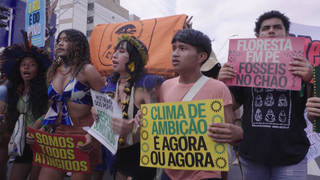
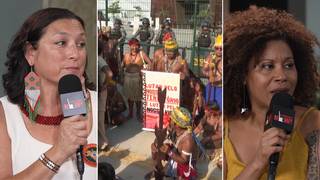
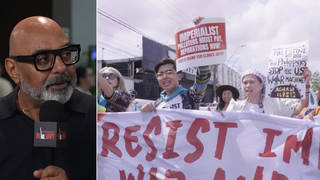
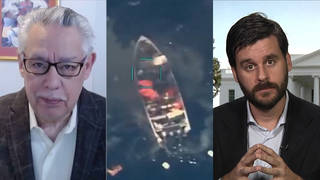





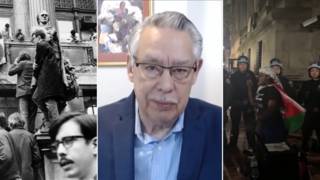
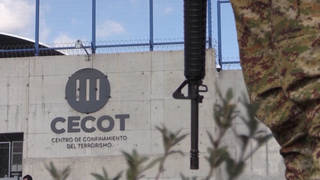
Media Options